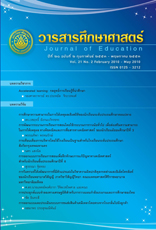ยุทธศาสตร์ส่งเสริมการบริหารจัดการน้ำท่วมซ้ำซากของ 14 ตำบลฝั่งซ้ายแม่น้ำบางปะกง-ปราจีนบุรีในมิติของชุมชน The Strategy of Recurrent Flood Management in 14 left side subdistricts of the Bangpakong-Prachinburi River in the Community Aspect
Keywords:
ยุทธศาสตร์ส่งเสริมการบริหารจัดการ น้ำท่วมซ้ำซาก มิติชุมชน, strategy of management, Recurrent flood, community aspectAbstract
บทคัดย่อ
การวิจัยเรื่องนี้มีวัตถุประสงค์เพื่อการสร้างยุทธศาสตร์ส่งเสริมการบริหารจัดการปัญหาน้ำท่วมซ้ำซากในมิติของชุมชนโดยวิธีการวิจัยเชิงคุณภาพ กลุ่มตัวอย่างเป็นประชากรใน 14 ตำบล ที่ตั้งถิ่นฐานอยู่ฝั่งซ้ายของแม่น้ำบางปะกง-ปราจีนบุรี โดยเก็บข้อมูลและวิเคราะห์ข้อมูลจากเอกสาร การศึกษาภาคสนาม การสนทนากลุ่ม การจัดเวทีประชาคม ผลการวิจัยพบว่า ปัญหาน้ำท่วมซ้ำซากเกิดขึ้น 2 ลักษณะ คือ ลักษณะแรกเกิดจากการที่ฝนตกหนักมีน้ำป่าไหลหลากจากต้นน้ำลงมามาก อีกลักษณะหนึ่งเกิดจากน้ำทะเลเอ่อหนุนจากปากแม่น้ำบางปะกงจนถึงแม่น้ำปราจีนบุรีเป็นประจำในฤดูน้ำหลาก ประกอบกับแม่น้ำเก็บกักน้ำได้ในระดับหนึ่ง เนื่องจากสภาพพื้นที่เป็นที่ราบสูงลาดลงสู่ที่ต่ำแบ่งเป็นพื้นที่ต้นน้ำ กลางน้ำ และท้ายน้ำ ในพื้นที่ต้นน้ำมีการปลูกพืชทำลายสภาพดินอย่างกว้างขวาง มีการทำลายป่าต้นน้ำ สำหรับพื้นที่กลางน้ำ เป็นการกระจุกตัวของภาคอุตสาหกรรม การขยายตัวของชุมชนเป็นเมือง ส่วนพื้นที่ท้ายน้ำมีการบุกรุกพื้นที่สาธารณะ ห้วย หนอง เพื่อทำการเกษตร ผลการวิเคราะห์กระบวนการเรียนรู้เชิงพื้นที่ พบว่า ในการแก้ปัญหาของพื้นที่จำเป็นต้องอยู่บนฐานความรู้ที่ถูกต้องด้วยการดำเนินกิจกรรมแบบมีส่วนร่วมของผู้ที่เกี่ยวข้องทุกฝ่าย ได้แก่ หน่วยงานภาครัฐ เอกชน และภาคประชาชน โดยแบ่งปัญหาออกเป็น 3 ประเภท ได้แก่ ปัญหาขนาดใหญ่ใช้พลังร่วมแบบเบญจภาคี ปัญหาขนาดกลางใช้การแก้ปัญหาในรูปของคณะกรรมการไตรภาคีเชื่อมโยงกับตำบลที่มีประสบการณ์เพื่อการแลกเปลี่ยนเรียนรู้ร่วมกัน และปัญหาเล็กให้ชุมชนจัดการกันเองโดยความร่วมมือกับองค์การส่วนท้องถิ่นให้การสนับสนุนประสานงานถือเป็นหัวใจสำคัญของความสำเร็จ ด้านการสร้างยุทธศาสตร์ส่งเสริมการบริหารจัดการปัญหาน้ำท่วมในมิติของชุมชนสรุปได้ 4 ด้าน ประกอบด้วย ยุทธศาสตร์ที่ 1 การแก้ไขปัญหาน้ำท่วมและตลิ่งพัง ยุทธศาสตร์ที่ 2 การแก้ไขปัญหาขาดแคลนน้ำในฤดูแล้ง ยุทธศาสตร์ที่ 3 การแก้ไขปัญหาน้ำเสียและมลภาวะกลิ่นเหม็นทางอากาศ และยุทธศาสตร์ที่ 4 เสริมสร้างศักยภาพของชุมชนให้มีความเข้มแข็งโดยการส่งเสริมกระบวนการเรียนรู้ในรูปของเครือข่ายชุมชนเพื่อส่งเสริมการบริหารจัดการของหน่วยงานภาครัฐในการแก้ไขปัญหาน้ำทุกด้านโดยชุมชนมีส่วนร่วมต่อไป
ABSTRACT
The objective of the research is to find the strategy of recurrent flood problem management by the qualitative research. The sample consists of inhabitants in 14 sub-districts located at the left side of the Bangpakong – Prachinburi River. Data were collected and analyzed based on the documents, field study, group discussion and organizing of people’s forum.
The research findings show that the flood problem can be classified into two categories. Firstly, it originates from precipitation and the outbreak of mountain torrents. Secondly, it results from the rising tide of briny water from the Bangpakong River to the Prachinburi River- usually occurs in the season of sweeping flood. The river is unable to retain the quality of water from the origin because of the geographical factors. In addition, the problem has relevance to cultivate the soil destroying plants, to trespass on the public areas such as brooks and ponds for agricultural activities changed from seasonal paddy field to off-season one. Interestingly, there is industrial sector congestion, transformation of rural area to city, and devastation of water originated-forest located in the middle area of the river. The result of learning process analysis found that the solution in the area should be based on the right knowledge by taking part in activities of all involved sectors, for example the government, private and people sector. There were three levels of problems; the main problem solved by five parties, the mid-level problem solved by three parties and the low level problem solved by the community in cooperation with the local organization that was the pivotal core for achievement. Incidentally, there were four strategies of recurrent flood management in the community aspect. Firstly, it is flood solution and bank erosion. Secondly, it is the solution of water inadequacy. Thirdly, it is the management of waste water and air pollution. Lastly, it is to strengthen the potential of community by facilitating a learning process of community network to support the government administration to solve all of water problems with community participations.
Downloads
How to Cite
Issue
Section
License
บทความทุกบทความเป็นลิขสิทธิ์ของวารสารศึกษาศาสตร์ มหาวิทยาลัยบูรพา



